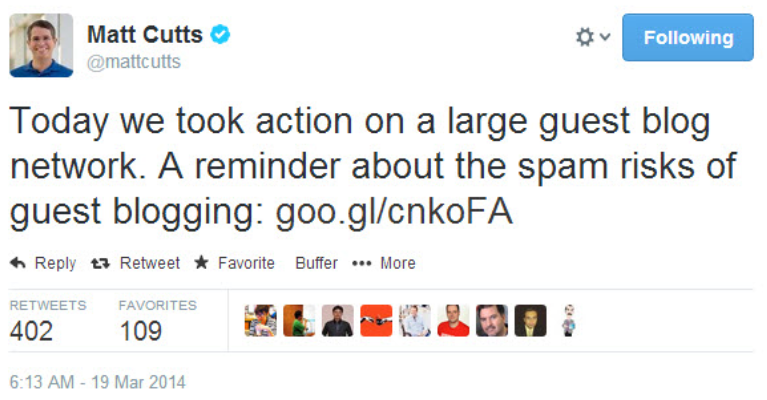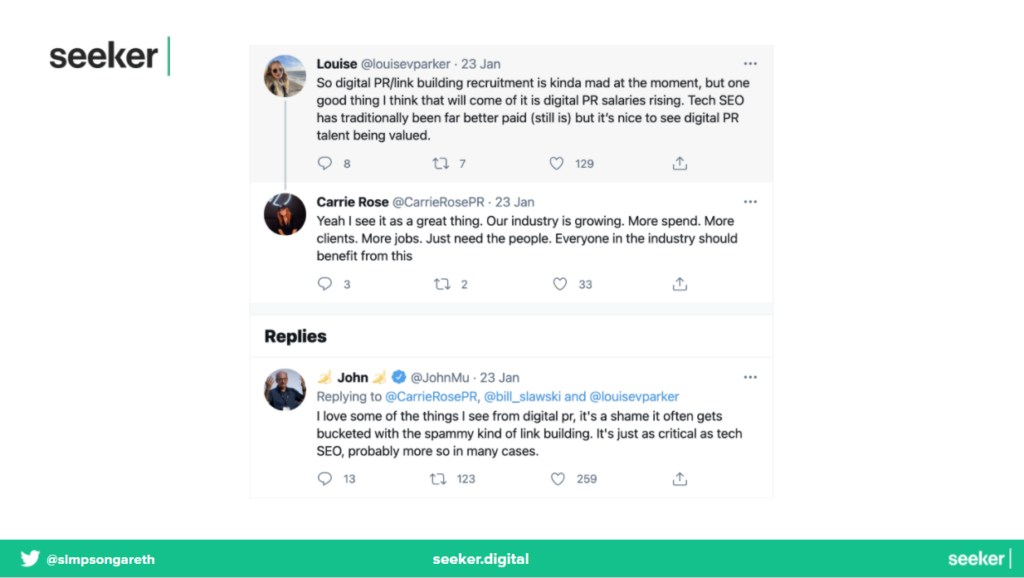
The spring iteration of BrightonSEO online saw Seeker’s founder Gareth Simpson take to the virtual stage with a look back (and forward) at the world of link building.
Spanning 15 years (and several algorithm updates), the talk looked at the dated link building tactics of 2006, the impact of the Penguin update, and what the future might hold for the link builders of tomorrow.
If you missed it (or want a quick refresher), read on.
A link to the past
In the beginning, there were links — primitive, unruly links, but links nonetheless.
When Gareth first got started in SEO back in 2006, helping his dad’s hobby sports website rise in the SERPs, link building was much more straightforward.
It was all about exact match anchors, link directories, and so on, a veritable Wild West of links—primitive, but effective.
With this basic approach to links came basic tools too.
Today, we are spoilt for choice for SEO tools: Ahrefs, Semrush, and so on were just a twinkle in the internet’s eye.
But back then, decent SEO tools were few and far between, and Gareth had to rely on sites like iBusinessPromoter and Backlink Watch to build, improve, and track his links.
Soon, Gareth launched his own SEO agency, offering his services for a number of clients, including a big construction firm.
Of course, just because link building back then was more rudimentary it doesn’t mean it was easy or straightforward. When his clients’ sites dropped in ranking, Gareth’s solution was to simply build more links.
Of course, this hindered rather than helped, so Gareth immersed himself deeper in the world of SEO, quitting his own solo business and joining a dedicated SEO agency to learn more about this then-arcane discipline.
Enter the Penguin
But then, in 2012, the Penguin update arrived.
While it had a cute name, the update itself was anything but. Laden down by too many anchor-led links, 40% of Gareth’s sites went down.
What followed was six months of clean-up, removing links and sending reconsideration requests after reconsideration requests (after reconsideration requests…) to get it all sorted—Gareth even printed off the Google Webmaster guidelines and stuck them to his desk as a constant reminder
While he didn’t know it at the time, the link building strategies Gareth (and the rest of the industry) employed didn’t add value in Google’s eyes. They were too self-serving, and didn’t always provide the all-important user with genuine value.
This was crucial—the Penguin updates sent a clear message: play nice, or don’t play at all.
It had to be the user, the wonderful user
This emphasis on user value had ripples throughout the SEO industry.
A focus on more user-centric tactics started to take shape: downloadable printables, video, free guides—real content that added real value to users’ lives.
As Gareth’s tactics evolved, so too did his competitors—link building got a whole lot quicker.
Leaning on MyBlogGuest, they began to exchange content for links.
While it started off well, with this came a minimum viable product approach, essentially minimum quality and maximum quantity of content in return for links.
But like many things in SEO, it got exploited. MyBlogGuest links started to become less effective, and soon Matt Cutts announced that the site had been penalised.

It was back to square one again, cleaning up links with reconsideration requests and removals.
Link building is out?
By the time the third Penguin update rolled out, the SEO industry was reeling from a number of impacts to their sites.
As a result, link building a near-taboo subject in SEO. Any deliberate attempts to build links were stopped, and even talking about their value for SEO became something of a faux pas.
For stakeholders, this was especially true. When bad links hit their bottom line, link building was out.
Founding Seeker Digital
In 2016, Gareth quit his agency job and started Seeker Digital, diving headfirst back into the world of link building, this time with care, caution, and a deep understanding and awareness of the Penguin update.
Google’s improved ability at combating link spam wasn’t bad for link building as a whole—it was bad for bad link building.
With this in mind, Seeker focused on quality and consistency, Leaning on tools like LinkResearchTools, Pitchbox, and Majestic to validate our work to build valuable links that played by the rules.
As a result, our clients enjoyed stellar (and sustainable) results.
Gareth was able to sell the value of links to boardrooms, and by specialising in link building as an agency, Seeker’s client base grew, helping us land a place on Deloitte’s UK Technology Fast 50.
We’ve come a long way, baby
Today, our link building strategies (and those of other agencies) straddle the fields of digital PR and SEO.
Combining PR strategies that put the brand front and centre with data-led SEO insight, we adopt a user-centric approach that embraces the best of both worlds.
Even Google is coming round to the idea:

John Mueller’s comments reflect an appreciative view of link building through digital PR—an acknowledgement that, when done right, it can add genuine value.
Here are a few tips from Gareth on how digital PR and link building can work together in harmony:
- Understand the mechanics of the algorithm—learn about technical SEO, crawling, indexing, and so on to broaden your knowledge
- Learn about the onpage signals that Google uses and make them part of your strategy
- Just building a link through to the domain is not enough—the authority and context needs to flow to the right pages
- Forget about domain-wide metrics—focus on context and relevance
- Build for the user, but ensure your accomplishments translate into SEO success
- PRs work with your techs, SEOs work with your PRs—unified goals
- Understand what algos are capable of technically in terms of reading signals, and assist the algos with additional input, algo aware
SEO isn’t just an arcane technical art—it requires a blend of both the creative and the technical in order to see real results.
Link building of tomorrow
So, what’s in store for the link building of tomorrow?
Gareth believes that we can expect more of the heavy lifting to be done for us. We already lean on automation to expedite our link building at Seeker, and as the tools and tech at our disposal evolves, it’ll only become more integral to link building.
Link building as a discipline will also become more accessible, with tools and resources available to help SEOs (and, indeed, digital PRs) from all walks of life embrace links.
Alongside this will come more focus on great content and strong coverage—a further merging of SEO and digital PR that appeals to the user (and Google).
But, predictions aside, Gareth admits to not following what the latest hype is.
Instead, he advises we focus on the fundamentals of technical SEO, review any of Google’s latest patents, and think about logistics and execution processes. What would you do if you were in charge of the algorithm? What would Google’s engineers focus on?
It is this that most informs Gareth’s link building strategy—a forecast for the future by focusing on the fundamentals.
Link building has come a long way since Gareth first started tinkering with his dad’s website. There have been dramatic changes in the past 15 years, and the next 15 years will only see more. But links are, and will remain to be for the foreseeable future, an essential part of the SEO landscape.
Has the above piqued your link building interest? Want to get started building a link-driven SEO strategy for your own brand or clients? Check out our SEO training services—the skills, expertise, and confidence to build your own SEO strategy from scratch.
